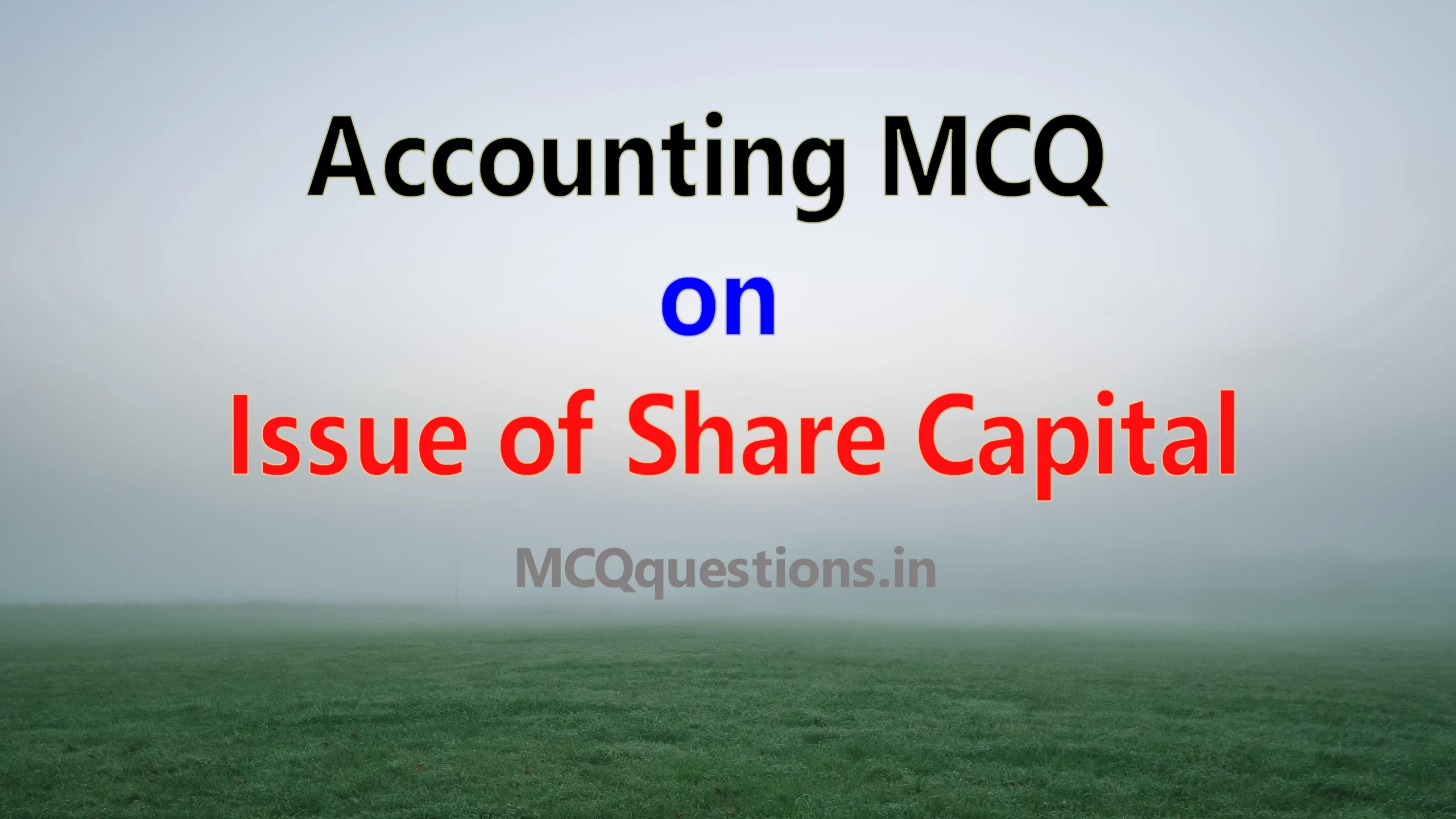
You can also read
MCQ on issue of Shares Capital
1. A company is a/an :
(a) Natural Person
(b) Artificial Person
(c) Both of the above
(d) None of the above
ANS. (b) Artificial Person
2. A Shareholder gets:
(a) Dividend
(b) Salary
(c) Commission
(d) Interest
ANS. (a) Dividend
3. The portion of the capital which can be called-up only on the winding up of the company is called:
(a) Authorised Capital
(b) Reserve Capital
(c) Uncalled Capital
(d) Issued Capital
ANS. (b) Reserve Capital
4. Equity shareholders are:
(a) Creditors
(b) Directors
(c) Owners
(d) None of these
ANS. (c) Owners
5. Securities Premium Reserve can be used for:
(a) Paying interest on debentures
(b) Meeting the cost of issue of shares
(c) Paying dividend on shares
(d) Paying tax liability
ANS. (b) Meeting the cost of issue of shares
6. The document required for issue of share capital by a company is:
(a) Prospectus
(b) Certificate of Incorporation
(c) Memorandum of Association
(d) Articles of Association
ANS. (a) Prospectus
7. Making an offer, inviting the public in general to subscribe for the shares is called:
(a) Initial Public Offer
(c) Over Subscription
(b) Minimum Subscription
(d) Pro-rata Allotment
ANS. (a) Initial Public Offer
8. If vendors are issued fully paid shares of Rs. 5,00,000 in consideration of net assets of
Rs. 4,50,000, the balance of Rs.40,000 will be debited to:
(a) Goodwill A/c
(b) Profit and Loss A/c
(c) Revenue Reserve A/c
(d) Capital Reserve A/c
ANS. (a) Goodwill A/c
9. Premium received on issue of shares is shown at:
(a) Assets side
(b) Equity and Liabilities side
(c) Debit side of Statement of Profit and Loss
(d) Credit side of Statement of Profit and Loss
ANS. (b) Equity and Liabilities side
10. After reissue of forfeited shares, the balance of ‘Share Forfeited A/e’ is transferred to:
(a) Capital Redemption Reserve A/c
(b) Revenue Reserve A/c
(c) General Reserve A/c
(d) Capital Reserve A/c
ANS. (d) Capital Reserve A/c
11. The maximum amount upto which a company can issue capital is called:
(a) Authorised Capital
(b) Issued Capital
(c) Called-up Capital
(d) Subscribed Capital
ANS. (a) Authorised Capital
12. A public limited company can raise share capital by issue of:
(a) Memorandum of Association
(b) Prospectus
(c) Articles of Association
(d) Certificate of Incorporation
ANS. (b) Prospectus
13. The maximum number of shareholders in a private company can be:
(a) 10
(b) 200
(c) 100
(d) Unlimited
ANS. (b) 200
14. A company can issue:
(a) two types of shares
(c) four types of shares
(b) three types of shares
(d) five types of shares
ANS. (a) two types of shares
15. The minimum number of shareholders in public limited company must be:
(a) 2
(b) 10
(c) 7
(d) 20
ANS. (c) 7
16. The maximum number of members in a public limited company is:
(a) Twenty
(b) Unlimited
(c)Fifty
(d) Two Hundred
ANS. (b) Unlimited
17. Preference shareholders get priority over equity shareholders:
(a) In payment of dividend only
(b) In refund of capital only
(c) In both payment of dividend and refund of capital
(d) In payment of interest
ANS. (c) In both payment of dividend and refund of capital
18. The amount received from shareholders towards share capital is:
(a) Authorised capital
(b) Called-up capital
(c) Paid-up capital
(d) Issued capital.
ANS. (c) Paid-up capital
19. The balance of Share Forfeited Account is transferred to:
(a) Profit and Loss Accountabl
(c) Revenue reserve
(b) Profit and Loss Adjustment Account
(d) Capital reserve
ANS. (d) Capital reserve
20. Calls-in-Arrear is:
(a) An expenditure
(b) An asset
(c) A liability
(d) An income
ANS. (b) An asset
21. Which of the following shares are convertible shares?
(a) Equity shares
(b) Preference shares
(c) All of the above
(d) None of the above
ANS. (d) None of the above
22. Which of the following is the main stage in the formation of a company?
(a) Promotion
(b) Incorporation
(c) Capital subscription
(d) All of the above
ANS. (d) All of the above
23. Which of the following defines the limits and scope of a company?
(a) Memorandum of Association
(b) Certificate of Incorporation
(c) Share Certificate
(d) Articles of Association
ANS. (a) Memorandum of Association
24. According to the Companies Act, which of the following is fixed as the rate of minimum subscription?
(a) 50% of the issue
(b) 90% of the issue
(c) 80% of the issue
(d) 60% of the issue
ANS. (b) 90% of the issue
25. When ‘Table F’ is applicable in case of a company, the company can charge interest call-in-arrears at the rate of not exceeding:
(a) 9%
(b) 8%
(c) 3%
(d)10%
ANS. (d)10%
26. When ‘Table F’ is applicable in case of company, the company is required to pay interest on calls-in-advance at the rate of not exceeding:
(a) 12%
(c) 5%
(b) 8%
(d) 4%
ANS. (a) 12%
27. Share Application account is a :
(a) Personal Account
(b) Real Account
(c) Nominal Account
(d) None of the Above
ANS. (a) Personal Account
28. Securities Premium Reserve is shown in the Balance Sheet under the sub-heading:
(a) Share Capital
(c) Current Liabilities
(b) Reserves and Surplus
(d) Non-current Liabilities
ANS. (b) Reserves and Surplus
29. When shares are allotted, which of the following account is credited?
(a) Share Capital A/c
(b) Share Allotment A/c
(c) Shareholders’ A/c
(d) Share Application A/c
ANS. (a) Share Capital A/c
30. Right issue of shares is issued to:
(a) Employees
(b) Directors
(c) Existing shareholders
(d) Public
ANS. (c) Existing shareholders